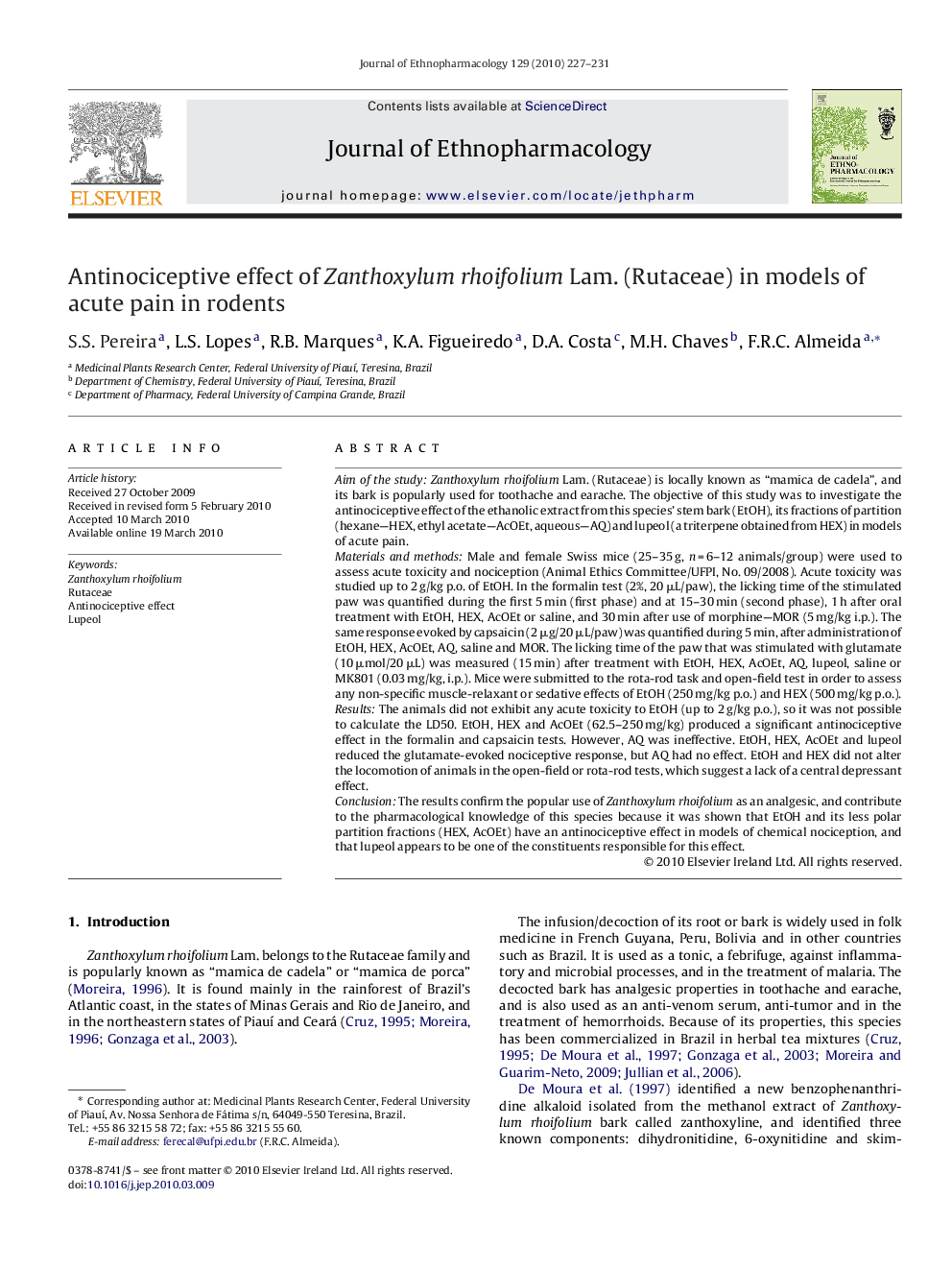| کد مقاله | کد نشریه | سال انتشار | مقاله انگلیسی | نسخه تمام متن |
|---|---|---|---|---|
| 2546283 | 1124021 | 2010 | 5 صفحه PDF | دانلود رایگان |

Aim of the studyZanthoxylum rhoifolium Lam. (Rutaceae) is locally known as “mamica de cadela”, and its bark is popularly used for toothache and earache. The objective of this study was to investigate the antinociceptive effect of the ethanolic extract from this species’ stem bark (EtOH), its fractions of partition (hexane—HEX, ethyl acetate—AcOEt, aqueous—AQ) and lupeol (a triterpene obtained from HEX) in models of acute pain.Materials and methodsMale and female Swiss mice (25–35 g, n = 6–12 animals/group) were used to assess acute toxicity and nociception (Animal Ethics Committee/UFPI, No. 09/2008). Acute toxicity was studied up to 2 g/kg p.o. of EtOH. In the formalin test (2%, 20 μL/paw), the licking time of the stimulated paw was quantified during the first 5 min (first phase) and at 15–30 min (second phase), 1 h after oral treatment with EtOH, HEX, AcOEt or saline, and 30 min after use of morphine—MOR (5 mg/kg i.p.). The same response evoked by capsaicin (2 μg/20 μL/paw) was quantified during 5 min, after administration of EtOH, HEX, AcOEt, AQ, saline and MOR. The licking time of the paw that was stimulated with glutamate (10 μmol/20 μL) was measured (15 min) after treatment with EtOH, HEX, AcOEt, AQ, lupeol, saline or MK801 (0.03 mg/kg, i.p.). Mice were submitted to the rota-rod task and open-field test in order to assess any non-specific muscle-relaxant or sedative effects of EtOH (250 mg/kg p.o.) and HEX (500 mg/kg p.o.).ResultsThe animals did not exhibit any acute toxicity to EtOH (up to 2 g/kg p.o.), so it was not possible to calculate the LD50. EtOH, HEX and AcOEt (62.5–250 mg/kg) produced a significant antinociceptive effect in the formalin and capsaicin tests. However, AQ was ineffective. EtOH, HEX, AcOEt and lupeol reduced the glutamate-evoked nociceptive response, but AQ had no effect. EtOH and HEX did not alter the locomotion of animals in the open-field or rota-rod tests, which suggest a lack of a central depressant effect.ConclusionThe results confirm the popular use of Zanthoxylum rhoifolium as an analgesic, and contribute to the pharmacological knowledge of this species because it was shown that EtOH and its less polar partition fractions (HEX, AcOEt) have an antinociceptive effect in models of chemical nociception, and that lupeol appears to be one of the constituents responsible for this effect.
Oral administration of Zanthoxylum rhoifolium stem bark extract (Graph A) and its fractions (HEX, AcOEt) (62.5–500 mg/kg) has an antinociceptive activity in different models of chemical nociception in mice. The activity is concentrated in less polar fractions (Graphs B and C), and the aqueous fraction was ineffective in all models. Lupeol is the main constituent in HEX and also has activity (Panel D).Figure optionsDownload as PowerPoint slide
Journal: Journal of Ethnopharmacology - Volume 129, Issue 2, 27 May 2010, Pages 227–231